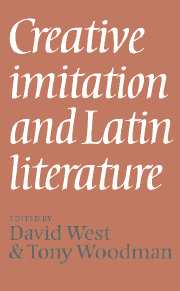Book contents
- Frontmatter
- Contents
- CONTRIBUTORS
- Prologue
- 1 DE IMITATIONE
- 2 PLAVTVS VORTIT BARB ARE: Plautus, Bacchides 526–61 and Menander, Dis exapaton 102–12
- 3 FROM POLYPHEMUS TO CORYDON: Virgil, Eclogue 2 and the Idylls of Theocritus
- 4 TWO PLAGUES: Virgil, Georgics 3.478–566 and Lucretius 6.1090–1286
- 5 HORATIAN IMITATIO AND ODES 2.5
- 6 IVDICIVM TRANSFERENDI: Virgil, Aeneid 2.469–505 and its antecedents
- 7 SELF-IMITATION WITHIN A GENERIC FRAMEWORK: Ovid, Amores 2.9 and 3.11 and the renuntiatio amoris
- 8 SELF-IMITATION AND THE SUBSTANCE OF HISTORY: Tacitus, Annals 1.61–5 and Histories 2.70, 5.14–15
- 9 LENTE CVRRITE, NOCTIS EQVI: Chaucer, Troilus and Criseyde 3.1422–70, Donne, The Sun Rising and Ovid, Amores 1.13
- 10 PYRAMUS AND THISBE IN SHAKESPEARE AND OVID: A Midsummer Night's Dream and Metamorphoses 4.1–166
- 11 EPILOGUE
- Notes
- Abbreviations and bibliography
- Select indexes
7 - SELF-IMITATION WITHIN A GENERIC FRAMEWORK: Ovid, Amores 2.9 and 3.11 and the renuntiatio amoris
Published online by Cambridge University Press: 12 March 2010
- Frontmatter
- Contents
- CONTRIBUTORS
- Prologue
- 1 DE IMITATIONE
- 2 PLAVTVS VORTIT BARB ARE: Plautus, Bacchides 526–61 and Menander, Dis exapaton 102–12
- 3 FROM POLYPHEMUS TO CORYDON: Virgil, Eclogue 2 and the Idylls of Theocritus
- 4 TWO PLAGUES: Virgil, Georgics 3.478–566 and Lucretius 6.1090–1286
- 5 HORATIAN IMITATIO AND ODES 2.5
- 6 IVDICIVM TRANSFERENDI: Virgil, Aeneid 2.469–505 and its antecedents
- 7 SELF-IMITATION WITHIN A GENERIC FRAMEWORK: Ovid, Amores 2.9 and 3.11 and the renuntiatio amoris
- 8 SELF-IMITATION AND THE SUBSTANCE OF HISTORY: Tacitus, Annals 1.61–5 and Histories 2.70, 5.14–15
- 9 LENTE CVRRITE, NOCTIS EQVI: Chaucer, Troilus and Criseyde 3.1422–70, Donne, The Sun Rising and Ovid, Amores 1.13
- 10 PYRAMUS AND THISBE IN SHAKESPEARE AND OVID: A Midsummer Night's Dream and Metamorphoses 4.1–166
- 11 EPILOGUE
- Notes
- Abbreviations and bibliography
- Select indexes
Summary
Imitation is one of the most difficult concepts in literary criticism. It is hard to establish in any literature criteria for determining with certainty when one passage is a conscious imitation of another. But in ancient literature there are additional obstacles: particular forms like epic or elegy have their own special and relatively limited subject matter and vocabulary; and important works in every form have been lost. The influence of generic ‘formulae’ and of recurrent topoi must also be taken into account. To some extent these factors cancel each other out. For example, a poet is more likely to imitate his own and other poets' earlier work when it is both in the same genre and in the same form. But nevertheless it is all too easy to suppose that imitation is present where it is not, or, where it is present, to make incorrect identifications of sources. Even when imitation is fairly certain and the principal source is known, problems remain. A work influenced by a specific literary predecessor may also be indebted to the stock material of a genre and to standard commonplaces. Again, when a predecessor is himself imitating an earlier work, imitation of the predecessor may involve a simultaneous reference to the earlier work. Finally, the poet may in addition to his principal source be adding material from one or more secondary sources. This is the so called contaminatio which seems to be a hallmark of much Hellenistic and post-Hellenistic literature. All these processes can be involved at once in a single work.
- Type
- Chapter
- Information
- Creative Imitation and Latin Literature , pp. 121 - 142Publisher: Cambridge University PressPrint publication year: 1979
- 2
- Cited by



